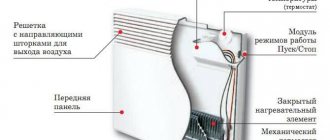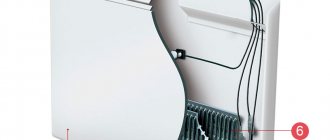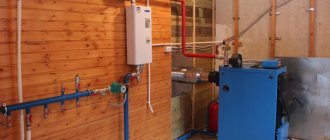The cold weather has arrived and the heating season has begun. There are many options for home heating, ranging from Russian stoves to high-tech boilers or central heating. But such options do not work everywhere and not always. Many people have unheated rooms or garages in their homes, or maybe country houses where they have not yet installed a heating system. In such cases, you will need the best infrared heater, and today we will try to tell you about such devices.
Infrared heaters and convective heating: operating principle
What is the difference between heating a room with an infrared ceiling heater and heating with convectors?
With convective heating, warm air, which is heated by interaction with the device, rushes upward, and cold air takes its place. Thus, the air higher up towards the ceiling is much warmer than near the floor. Accordingly, no convector can heat a room instantly; for this it will take time, since the air in the near-ceiling area must heat up first.
The case with infrared heaters is exactly the opposite. With such heating of the room, on the contrary, it will be warmer below than above, and closer to the ceiling the air temperature decreases, which, in fact, is an undoubted advantage of infrared heating. How do infrared heaters work? These devices do not heat the air at all; their action is directed at objects in the room, as well as at the walls and ceiling: absorbing infrared rays, they heat up.
The principle of operation of the system is compared to the operation of the sun: the infrared waves that heat the room correspond to the range of radiant energy of the luminary. Consequently, heat is felt immediately after turning on the heater, although not in the entire room, but of a local nature, that is, in that very place of radiation.
Advantages of infrared heating plates
Infrared heating stoves have the following main advantages compared to traditional heating systems:
- rooms can be heated up to 50 degrees;
- the ability to maintain optimal levels of temperature and humidity;
- lack of convection air currents that raise dust.
The infrared heating type can be installed in different ways; it can be either the main or secondary heating system paired with another type. To choose the most suitable type of heating for your home, you need to take into account the heating system you already have, the materials from which the house is built, and much more.
According to customer reviews, the main characteristics by which they choose these heating devices are as follows:
- the presence of a thermostat that allows you to maintain a certain mode and save energy;
- achieving a minimum difference between the air temperature on the ceiling and on the floor during heating;
- lack of pipes, radiators and boilers;
- the ability to place the panel both on the ceiling and on the wall, the effect will be the same;
- the possibility of laying tiles or drywall on top of the panels and even gluing wallpaper on top;
- the service life of infrared devices reaches 50 years;
- high level of fire safety;
- environmental friendliness of the device.
Choosing an infrared heater: what is important to know
What should you consider when choosing a ceiling infrared heater?
- Firstly, it is important to decide whether this type of heater will be used as a basic one or will its function only be additional heating of the room? That is, before making a choice, you need to take into account the purpose of using the device and the intensity of its work.
- Secondly, it is advisable to take into account the technical characteristics of the room for which the device is selected. For example, you need to pay attention to the walls (how thick are they, are they insulated from the outside), the ceiling (there is an apartment or roof on top (if there is a roof, then what condition is it in and what is the quality of insulation); windows (what kind of windows are in the room, how tightly the glass is in contact with the frame), etc. The combination of these factors has a direct impact on the heat loss of the room, therefore, these characteristics determine the choice of heater.
- Thirdly, it is important to decide which manufacturer’s product will be the best. As a rule, they choose a product from the brand that has proven itself to be the best and where the price corresponds to the quality. Advice from friends and acquaintances regarding this or that brand can also help in resolving the issue. And, of course, no one excluded reviews about the product on the Internet. They may not create a complete picture, but they will give a general idea.
Domestic brand IR heaters
Speaking about infrared heaters, one cannot fail to mention the domestic brand “Peony”. If you believe the advertising, this technique is high class. It has a fundamentally new design: the dispersion angle of long waves is greater than that of most brands from other manufacturers. In addition, “Peony” is fireproof and does not make unnecessary noise, which is the problem with many infrared heaters. Infrared radiation plates of this brand are quite reliable and, as the manufacturer assures, have a longer service life than other brands. In addition, Peony has an exquisite design and is relatively inexpensive.
To consider installing a ceiling infrared heater, you can use this brand as an example.
Comparison table of characteristics
In the table, we have compared the technical characteristics of the presented electric heaters so that you can easily compare and, perhaps, choose among them your future savior from the cold.
| Model | Heating Power (W) | Heated area (m²) | Number of operating modes | Warranty period (year) | Model weight (kg) | Device dimensions (cm) | Cost (rubles) |
| Nikaten NT 300 | 300 | 6 | 1 | 5 | 11 | 60×40×4 | from 2,980 to 3,440 |
| Ballu BIH-APL-0.6 | 600 | 6 | 1 | 2 | 2,2 | 88,5×4×13 | from 1,613 to 2,738 |
| Hintek IW-03 | 300 | 6 | 1 | 1 | 3,3 | 70×40×5 | from 2,477 to 2,986 |
| Hyundai H-HC3-06-UI999 | 600 | 10 | 2 | 1 | 0,76 | 32×23,5×8,7 | from 572 to 990 |
| Ballu BIH-S2-0.3 | 300 | 6 | 1 | 5 | 3,4 | 59×59×3,5 | from 1,722 to 3,488 |
| Bagan REN-5 | 500 | 15-20 | 1 | 5 | 1 | 80×60 | from 1,990 to 3,890 |
| KALASHNIKOV KIRH-E10P-11 | 1000 | 20 | 1 | 3 | 3,4 | 136×13×4,5 | from 2,650 to 3,200 |
| Ballu BIH-LM-1.5 | 1500 | 25 | 3 | 2 | 3,5 | 35×46×31,5 | from 2,390 to 4,879 |
| Peony Thermoglass Ceramic-10 | 1000 | 20 | 1 | 3 | 4,,6 | 80,5×29,5×1 | from 5,550 to 5,850 |
| Ballu BHH/M-10 | 800 | 14 | 2 | 1 | 0,9 | 37×30,5×13,6 | from 961 to 1,623 |
Installation of a ceiling infrared heater (using the example of the Peony brand)
There are several simple rules that should not be forgotten when installing a ceiling infrared heater:
- Safe fastening is the first prerequisite. It must hold the device securely and not deform.
- It is best to install the heater using the fasteners that come with the device.
- The heating surface of the device must not come into contact with materials that may ignite.
- Wires must be insulated for safety reasons.
What is included in the “Peony” ceiling infrared heater kit? Actually, the heater itself, installation kit, operating instructions, warranty. Thermostats must be purchased separately.
What is a heater? This is a device about half a meter long under the ceiling, to some extent resembles a lamp, but does not glow. Only a small light is on while the device is operating, but if it is turned off, the device, accordingly, does not work - it’s like an indicator.
The manufacturer assures that even an inexperienced beginner can install the heater. The hooks are screwed to the ceiling, chains are hung on them, and there is a groove on the heater where these chains need to be inserted. The user can adjust the size of the chain at his own discretion. Of course, if the ceiling is wooden or suspended, installing the device will be easier than if the ceiling is concrete and the ceiling will have to be drilled. However, the hangers are generally quite easy to install. The wires are secured using a terminal box, which is covered with a protective casing.
Thermostats that can be used in conjunction with a heater can be mechanical or electrical. There are no questions with mechanical regulators: you just need to set a certain temperature. The situation with electric ones is more interesting: they can be programmed, for example, for a week. Some electric thermostats allow you to set only basic parameters. Others can be reprogrammed entirely according to the user's wishes. Although such thermostats are used quite rarely, and this is not only due to possible difficulties in setting them up. The price category of electric thermostats scares off even connoisseurs of their enormous capabilities.
The infrared heater also provides the ability to use a thermostat (although it is not included). This creates additional convenience for the user: the heater will not work 24 hours a day. The thermostat will turn on the heater when needed.
Is exposure to infrared heaters harmful to human health?
As soon as the cold weather sets in, people begin to experience discomfort from insufficient room temperature, cold floors and unheated beds. This can be avoided by installing modern climate control equipment. Most often the choice is an electric heater. But not many people know the benefits and harms of an infrared heater. Recently, these heating systems have become increasingly popular.
What is an infrared heater?
Infrared devices have a simple design - they use special heating elements that generate infrared radiation. This type of radiation is thermal, and it is emitted not only by the sun, but also by any other heat sources. It is these rays that make it possible to warm living spaces, as well as open and semi-enclosed areas.
The operating principle of such units is similar to the main source of infrared rays - the sun and is manifested in the following:
- Creation of thermal IR rays.
- Transfer of received heat to surrounding air masses.
- Absorption of IF rays on floor, wall and ceiling surfaces.
- The emergence of a thermal effect indoors based on this radiation.
If we think in a global sense, then every object that gives off heat, i.e. actually being its source, may well be considered an IR heater.
The following heaters are distinguished by wavelength:
- emitting long waves reach an operating temperature of +300-400°C.
- with medium waves they reach an operating temperature of +400-600°C.
- using short waves, have a standard temperature that reaches +800°C, and sometimes even exceeds this parameter.
Specially created heating systems of this type are based on a different design, but at the same time have an identical operating principle. The reflector and emitter included in the design form the necessary IR rays and direct them in the desired direction.
Types of IR heaters. There are several types of infrared heaters:
- Floor-standing.
- Wall-mounted.
- Ceiling.
Which of these options is most preferable depends on the purpose and installation location.
In a house where there is a child, you should install only wall-mounted appliances, while keeping the height out of reach for his growth.
In a room with low ceilings, installing a ceiling option is undesirable, since there is a high risk of overheating of household appliances and furniture. Also, this option is not recommended for installation in a children's room, bedroom and other places of long-term stay.
Floor-standing specimens are quite mobile, their location can be changed. Their use eliminates the risk of overheating any part of the body.
The benefits and harms of an infrared heater in an apartment or private house
When studying the harm of such units to humans, one should understand their principle of operation. It is quite simple - IR radiation leaves the heater, reaches surrounding objects, the floor, and begins to warm them. These, in turn, heat up, releasing heat into the atmosphere.
This heating method is more effective compared to convection, which heats only air masses.
Infrared radiation is also felt by humans, perceiving it in the form of a directed warm air flow.
What are the benefits of IR heaters? Such devices provide:
- Rapid spread of heat throughout the room - IR radiation spreads over a fairly large distance at the speed of light (hot air from convectors heats a smaller area and arrives tens of times slower).
- They maintain the required amount of oxygen in the air - the oxygen necessary for breathing is not burned and its percentage remains at the same level.
- Maintain air humidity - this indicator remains unchanged.
- They allow local heating and do not dry out the air.
- Characterized by high efficiency and cost-effectiveness.
- They do their job silently.
Harm of an infrared heater:
- Even if the unit is selected according to the area of the room, this does not guarantee absolute safety.
- Often, damage from infrared heating systems is caused by using them for too long or installing the system in violation of safety rules.
The heat emanating from the heater is not absorbed by the environment, since it is electromagnetic waves. Such radiation sources will provide warmth and comfort not only in a certain area of the apartment or house, but also in the country house, gazebo and other recreation areas. Thus, the benefits of heating systems of this type are obvious.
According to experts, carbon infrared heaters have the best characteristics - they are superior to other heating devices in terms of their economy and efficiency.
Health benefits for humans and pets
Such heating devices have an extensive list of advantages that help you choose them. Currently, there are results of using similar products (with long-wave infrared radiation) in medical institutions in the CIS countries, Japan, China, USA, Canada, etc.
Devices based on long-wave infrared radiation have two types of positive effects on the human body:
- The first type is due to the general strengthening effect on human health as a whole. Its result is the prevention of various diseases and premature aging. This type of impact is based on strengthening the immune system and the body's resistance to disease. Thus, the use of IF radiation is to some extent a form of therapy that is completely different from surgery and chemotherapy. Therefore, it is suitable not only for general household use (at home, in the office, etc.), but also for health centers and medical institutions as a physiotherapeutic procedure.
- The second type of positive IF radiation on the human body is the direct treatment of diseases and general ailments. In these cases, these products have a direct therapeutic effect. Infrared waves penetrate the body, warm up organs, tissues, muscles and joints, thereby accelerating the lymphatic flow of the blood, and increasing blood circulation in the muscles increases the metabolic process.
Possible harm from the device
If such heating systems are used too long and often, while being under direct influence of infrared rays, and if they are not operated correctly, this can cause a number of negative consequences.
Harm to health from infrared heaters:
- Getting heatstroke, accompanied by pain in the head, dizziness, nausea and loss of consciousness.
- Prolonged exposure of a person to short infrared rays can have consequences in the form of redness on the skin, as well as the appearance of blisters at the site of their intense exposure.
- In rare cases, due to long-term exposure to the organs of vision, short-wave rays can cause serious negative consequences, the most severe of which may be the occurrence of cataracts.
It is worth noting that all negative consequences are due to excessive exposure to short-wave infrared waves on humans.
How can you prevent harm from exposure to infrared equipment? Scientists, doctors and manufacturers of thermal equipment are warning about the possible consequences caused by excessive exposure to infrared radiation.
At the same time, there are a number of recommendations that can help avoid harm to the human body:
- It is not recommended to use this open type device with short IR waves.
- If a person is close to the source of infrared rays, their exposure should be limited.
- Use clothing that is protected from infrared radiation.
- Use heat shields on such equipment.
- It is not recommended to install such heating systems in bedrooms and children's rooms, but if this is a necessary measure, then it is necessary to choose low-power models.
- Install heaters in rooms in such a way that they are at an optimal distance from people. An excellent option are ceiling systems that are installed at a maximum height.
- Use only high quality models from trusted manufacturers. Heating equipment made from low-quality materials often causes harm.
The above factors largely exclude harm to human health.
Expert opinion on the benefits and possible harm of an infrared heater:
The results of scientific research have confirmed the positive effects of long-wave infrared rays on the human immune system. However, this conclusion only applies to their short-term effects.
With prolonged directed heating, the skin becomes dry and overheated, which negatively affects its condition.
In addition, burns to the lens and retina are possible, so experts do not recommend looking at the heated elements of such equipment for a long time.
Reviews from doctors regarding the positive and negative effects of IR heaters
According to doctors, the therapeutic effects of infrared rays can be used for the following conditions and diseases:
- Focal pneumonia.
- Bronchial asthma, exacerbation of chronic bronchitis.
- Chronic gastroduodenitis.
- Chronic cholecystitis (calculous).
- Hypermotor dyskinesia of the digestive organs.
- Rheumatoid arthritis is in remission.
- Osteochondrosis of the spine with various neurological manifestations.
- Obliterating atherosclerosis of leg vessels.
- Urolithiasis disease.
- Chronic adnexitis, ovarian dysfunction.
- Exacerbation of chronic cystitis.
- Exacerbation of chronic prostatitis with signs of impaired potency.
Heating using infrared radiation suppresses the proliferation of pathogenic bacteria in the environment and the human body, and improves skin condition by increasing blood circulation. Air ionization is a good prevention of allergy exacerbations.
Negative impact. Before using infrared rays for medicinal purposes, you should familiarize yourself with the existing contraindications:
- Bleeding.
- Acute purulent diseases.
- Systemic blood diseases.
- Acute inflammatory diseases that contributed to decompensation of organs and systems.
- Malignant neoplasms.
In addition, excessive exposure to infrared rays causes skin redness, blistering and can cause burns.
Safety precautions and features of the location of infrared heaters
When using infrared equipment, you need to take into account the features of its location, as well as the rules for safe use.
- General and local heating:
When organizing general heating, you need to calculate heat losses. To obtain reliable data, information will be required on the area of available premises, the thickness and materials of structural fences, and the technical features of the functioning of the ventilation system.The rated power of the heating equipment must correspond to the total amount of heat loss. Then the type of IR heater is selected based on the area of the room and the installation height of the heating unit.
- Heating of individual zones.
With the help of such installations it is possible to maintain a certain temperature within the room. If it is necessary to maintain a temperature of 20 °C in any zone, you will have to use a device more powerful than in other parts of the room.
The most effective means of financial and energy costs is zone heating.
- Determining the optimal installation height
When installing one or more heaters, it is recommended to maintain a distance. In places where people are constantly present (workplaces, bedrooms, etc.), devices should be located at a distance of 1.5-2 m from the head of a standing, sitting or lying person. - Practical installation features
To carry out the process efficiently, it is not necessary to have technical knowledge or experience - any person of strong physique is able to install an infrared heater. The most important thing is to determine the optimal location for its location.- The source of infrared radiation should be located at a distance from the person, since discomfort associated with overheating is unlikely to be avoided.
The actual distance is determined only based on the power of the specific device. If the value is 700-800 W, then the device can be placed 0.7 m from a person, with a unit power of 1-1.5 kW, you should move it away from you at least a meter.
- A model with a power of 700 W can be installed in any part of the room with a ceiling height of 2.5 m. A significant excess of power indicators (1.5-2 times) requires careful consideration of the installation procedure. In this case, the choice can be made in favor of a relaxation area in the bedroom or a workplace.
- Movable brackets that allow the heaters to be positioned at a horizontal angle will help get rid of discomfort. In addition, they make it possible to mount heating equipment both on the ceiling and on the wall.
High-quality infrared heaters, selected and placed in accordance with established safety rules, will not cause harm to health. They will provide high comfort and energy savings.
Modern infrared units are quite efficient, hygienic and do not require special maintenance. Due to their high heating efficiency, such devices not only create warmth in the room, but also bring health benefits. Buying such equipment is a really good choice.
Apr 20, 2018ventsyst
Rules for using an infrared ceiling heater
In fact, caring for ceiling heaters is very basic: all you need is to periodically wipe them from dust.
Infrared rays are not harmful to the human body, some even claim that they have a positive effect on health. However, it is not recommended to stay in direct light for long periods of time. Since the principle of operation of an infrared heater is similar to the operation of the sun, if you stay under the “artificial sun” for a long time, you can quite reasonably get a heat stroke. Accordingly, you should not use very powerful devices in a room with a small square footage. It is important to adhere to the following rule: it is better to have more infrared heaters with low power than one with high power.
Ceiling short-wave heaters are also not recommended: short waves can penetrate the body and be harmful to health.











